|
Report from
Europe
Half UK tropical timber trade value lost in May
After a sharp fall in UK imports of tropical timber
products in May and June in response to the COVID-19
pandemic, imports rebounded strongly in July and made
more gains in August. However, even in August, total
imports were still down around 15% compared to the same
month the previous year (Chart 1).
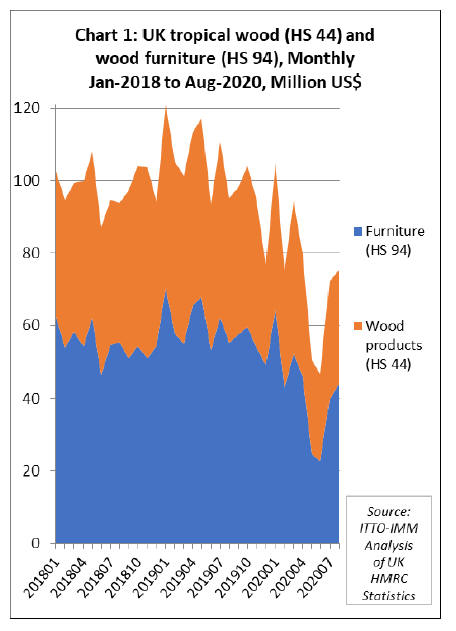
A strong rebound in construction and other broader
economic measures during the summer months gave rise
to optimism that the downturn may be short-lived and the
recovery would be ¡°V-shaped¡±. More recent indications,
however, are of a ¡°tick mark¡± recovery, with the sharp fall
followed by a longer tail of recovery.
Now new lockdown measures are being imposed in the
UK with mounting concern about a second wave of the
virus which might yet overwhelm health facilities. The
withdrawal of short-term government support measures,
notably the furlough scheme designed to keep more people
in work during the first lockdown, also raises the prospect
of a spike in unemployment during the winter months.
Overall UK imports of tropical wood furniture products to
end August this year were US$337 million, 31% less than
the same period in 2019. Imports fell to only US$24.5
million in May, 60% down on imports typical for that
month in a normal year. However, tropical wood furniture
imports recovered to US$40 million in July and US$44
million in August.
UK imports of wood furniture declined sharply from all
the leading tropical supply countries in the first eight
months of this year (Chart 2). Imports from Vietnam were
down 34% at US$168 million, imports from Malaysia fell
32% to US$71 million, imports from Indonesia declined
31% to US$31 million, and imports from India fell 34% to
US$24 million. However, there was an 8% rise in imports
from Singapore, to US$25 million.
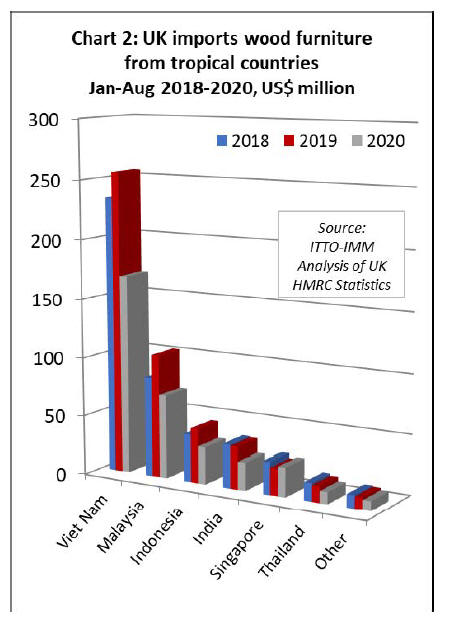
The total value of UK imports of all tropical wood
products in Chapter 44 of the Harmonised System (HS) of
product codes to end August this year was US$262
million, 29% less than the same period in 2019.
Imports fell from US$34 million in April to US$26 million
in May and continued to slide to US$24 million in June.
They then recovered to US$33 million in July before
slipping back to US$31 million in August.

Comparing the first eight months of 2020 with the same
period in 2019, total UK import value of tropical joinery
products was down 15% at US$94.2 million, tropical
plywood was down 40% at US$82.4 million, tropical
sawnwood fell 30% to US$47.5 million, and
mouldings/decking declined 43% to US$11.2 million
(Chart 3).
Although UK imports of all HS Chapter 44 wood products
from the tropics have fallen sharply this year, the timing of
the decline and subsequent recovery has varied by product
group (Chart 4).
For example, the decline in imports of tropical sawnwood,
which were quite buoyant before the COVID lockdown,
was short-lived and followed by a strong recovery in July
and August. In contrast, UK imports of tropical plywood
were sliding even before the lockdown and had barely
recovered by the end of August.
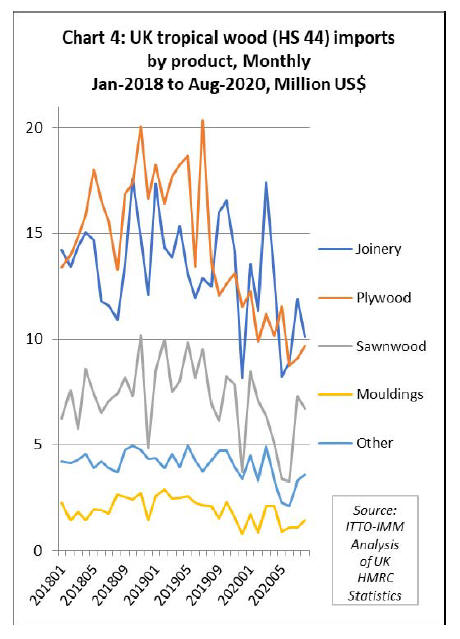
Indonesia loses ground in UK joinery market
After making gains in 2019, UK imports of tropical
joinery products from Indonesia, mainly consisting of
doors, fell 19% to US$54 million in the first eight months
of this year (Chart 5).
UK imports of wooden doors from Indonesia were quite
strong in March and April but were slow between May
and August. It is not unusual for these imports to vary
widely each month, even in a normal year, and it is
therefore difficult to predict how the trade will develop for
the rest of the year.
After a strong start to the year, UK imports of joinery
products from Malaysia and Vietnam (mainly laminated
products for kitchen and window applications) stalled
almost completely in May and recovered only slowly in
the following months.
Total joinery imports in the first eight months were down
9% to US$24 from Malaysia and down 9% to US$6
million from Vietnam. UK trade in joinery products
manufactured from tropical hardwoods in neighbouring
Ireland have also fallen dramatically this year, down 29%
to US$3.3 million in the first eight months.
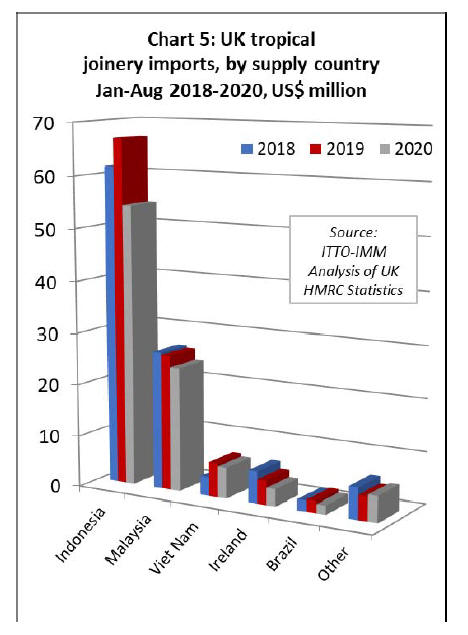
UK imports of tropical hardwood plywood from China
recover slowly
The UK imported 66,800 cu.m of tropical hardwood faced
plywood from China in the first eight months of this year,
55% less than the same period last year (Chart 6). UK
imports of plywood from China ground to halt earlier this
year when China went into lockdown.
There were hardly any deliveries from February through to
early April and UK importers were forced to live off
inventories.
UK importers report that through April and May this year
Chinese plywood supply recovered steadily. By July,
supply was back to normal and significant volumes under
delayed contracts began to arrive.
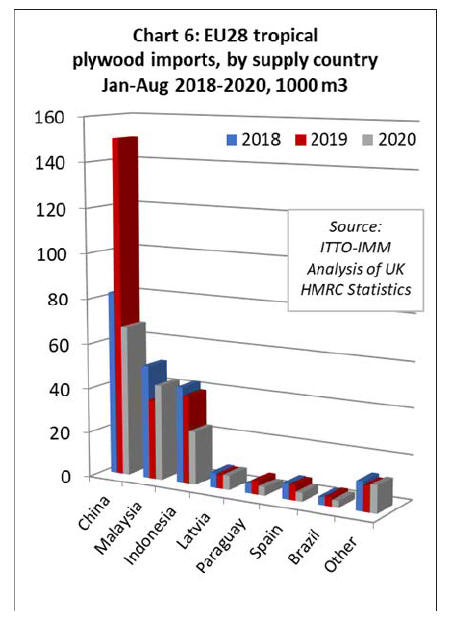
It is expected that some of the lost volume from China will
be made up later this year. On the other hand, rising
freight rates, up in the last couple of months from
US$1,300/1,400 FEU toUS $2,000, strengthening of the
CNY against the dollar, and higher raw material costs are
now impacting China¡¯s competitiveness in the plywood
market.
Likely due to supply problems in China, UK imports of
plywood from Malaysia, which have been in long term
decline, have recovered ground in 2020. Despite
significant slowing in May, imports from Malaysia were
still up 20% at 42,600 cu.m for the first eight months of
the year.
In contrast to Malaysian plywood, UK imports of
Indonesian plywood fell 40% to 23,900 cu.m in the first
eight months of the year. In addition to supply problems
during the pandemic, Indonesian plywood has come under
very intense competitive pressure from Russian birch
plywood this year. Russian plywood is reported to have
become more competitive overall, with the rouble sliding
from 77 to the euro in June to over 90 in September.
Indonesian plywood has lost share particularly in the large
market for 18-21mm film-faced for construction where
Russian birch now dominates. Although Indonesian supply
is now reported to be back to normal, albeit with freight
rates increasing costs, UK imports of Indonesian plywood
are now focused more on more niche products such as
thinner plywood and for overlay and 2.7mm items for the
caravan industry.
In recent years, the UK has been importing small volumes
of tropical hardwood faced plywood from Latvia and
Spain. In the first eight months of 2020, imports increased
4% to 6,800 cu.m from Latvia but fell 43% to 3,900 cu.m
from Spain.
UK tropical sawn hardwood imports rising from Latin
America
The UK is now a relatively minor market for tropical sawn
hardwood, importing less than 100,000 cu.m in each of the
last two years, making it only the fifth largest European
importer for this commodity (after Belgium, Netherlands,
France and Italy).
While the UK trade in sawn tropical hardwood fell sharply
in May and June this year, there was some recovery in
July and August, particularly from Latin America.
However imports were still down from most major supply
countries by the end of August (Chart 7).
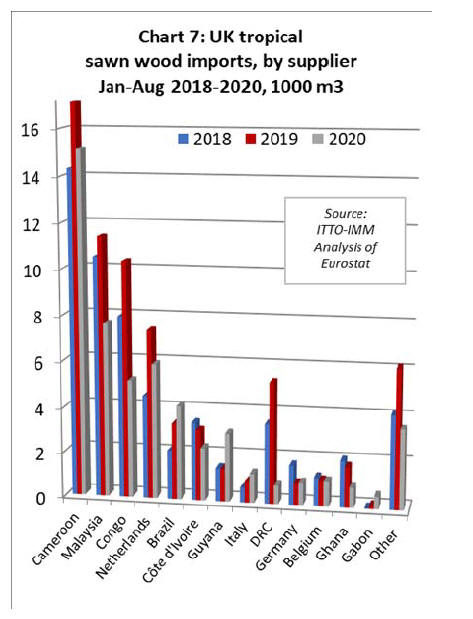
UK imports from Cameroon, the leading supplier, fell
12% to 15,100 cu.m in the eight-month period, while
imports from the Republic of Congo declined 50% to
5,200 cu.m. Of other African suppliers, imports were
down 25% to 2,300 cu.m from Côte d'Ivoire, down 85% to
only 810 cu.m from DRC and down 51% to 887 cu.m
from Ghana.
While UK imports of African hardwoods suffered severely
during the COVID lockdown this year, there is some
optimism that trade will recover well in coming months.
Recent market discussions at the London Hardwood Club
suggested that trade in the favoured African species
(dominated by sapele in the UK) is ¡°now at normal
levels¡±.
It was also noted that UK is ¡°well stocked but not
overstocked¡± in African hardwoods. However, sapele is
currently being traded at unsustainable price levels, below
replacement cost.
UK imports from Malaysia were 7,700 cu.m in the first
eight months of 2020, 33% less than the same period in
2019. Indirect imports into the UK via the Netherlands
were down 20%, at 5,900 cu.m, after significant growth
last year.
However imports from Brazil increased 23% to 4,200
cu.m in the first eight months of 2020, with particularly
good growth during the summer months after lockdown.
Imports from Guyana also increased, rising 107% to 3,000
cu.m in the first eight months of the year.
Economic forecasts in the UK becoming a little more
optimistic
The latest October report of the EY Item Club, a leading
UK economic forecasting body, is slightly more optimistic
than the previous report in July. According to the Club, the
UK economy may have grown by as much as 17% in the
three months to the end of September. This compares to
their earlier prediction of only 12% growth.
However the Club believes slower growth may follow,
with a fall to 1% or less predicted for the final three
months of this year. The end of the furlough scheme,
under which workers had part of their salary paid by the
government, will mean higher unemployment and sluggish
growth, said the forecasters.
"The UK economy has done well to recover faster than
expected so far," said Howard Archer, chief economic
adviser to the EY Item Club. "Consumer spending has
bounced back strongly, while housing sector activity has
also seen a pick-up, in part thanks to the stamp duty
holiday."
That said, the UK economy is now predicted to regain its
pre-pandemic size in the second half of 2023. Back in
July, the EY Item Club did not expect that to happen until
late 2024.
However, there is a high level of uncertainty surrounding
this forecast. While a vaccine is likely to help the
economy, the downside risks are significant. Factors that
could weigh down growth include a drop in consumer
spending, more lockdown measures, a spike in
unemployment and slow Brexit negotiations between the
UK and the EU.
On the last point, the Club's estimates assume a simple
free trade agreement with the EU by the end of the year.
Without an agreement, growth of 4.8% is forecast in 2021,
down from 6%, while growth in 2022 would be cut to
2.6% from 2.9%.
More positive, particularly for having a more direct
bearing on timber demand, is that the latest data on
purchasing managers sentiment in the construction sector
from IHS Markit and UK Chartered Institute of
Procurement and Supply (CIPS) signals another sharp
increase in UK construction activity at the end of the third
quarter.
The expansion came amid the sharpest rise in new UK
construction business since before the pandemic-induced
lockdown, with firms increasing their purchasing activity
at the quickest pace for nearly five years.
The headline seasonally adjusted IHS Markit/CIPS UK
Construction Total Activity Index registered 56.8 in
September, up from 54.6 in August. Any figure above 50.0
indicates growth of total construction output. The latest
reading pointed to a reacceleration in the rate of activity
growth and a sharp increase overall.
Underlying data revealed varied results across the three
monitored sub-sectors. The strongest performing category
was home building, where firms registered a sharp
expansion in activity for the fourth month running. Work
undertaken on commercial projects also rose strongly,
increasing at quickest pace for over two years. Meanwhile,
civil engineering activity fell for the second month
running and at the sharpest rate since May.
Looking forward, confidence towards the 12-month
business outlook in UK construction was the strongest
since February. Optimism was supported by expectations
of a sustained rise in new work.
Commenting on the latest PMI data, Duncan Brock, Group
Director at CIPS said "UK Construction took off in
September, soaring ahead of both the manufacturing and
service sectors in terms of output growth and recording the
fastest rise in purchasing activity since October 2015.
Fuelled by the easing of lockdown measures, new orders
rose for the fourth month in a row and at the quickest pace
since the beginning of the year before the pandemic
struck¡±.
While Mr Brock was concerned about the potential impact
on employment as ¡°government support schemes are
winding down¡± he suggested that ¡°for now, builders are
stocking up for Brexit and Covid-19 preparations, so
purchasing remains strong in spite of longer delivery times
and some shortages¡±.
|